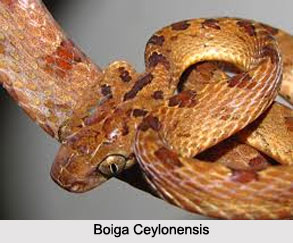 Boiga Ceylonensis which is also known as Srilanka Cat Snake found in the Western Ghats Mountain Range in India and the South Indian states.
Boiga Ceylonensis which is also known as Srilanka Cat Snake found in the Western Ghats Mountain Range in India and the South Indian states.
Category of Boiga Ceylonensis
Boiga Ceylonensis can be identified from other members of the genus Boiga by the following scalation and taxonomic characters.
Teeth of Boiga Ceylonensis
The anterior palatine and mandibular teeth of Boiga ceylonensis are not any larger than those at the posterior positions.
Eye of Boiga Ceylonensis
The eye of Boiga Ceylonensis is shorter than the snout.
Scale of Boiga Ceylonensis
The rostral scale of Boiga Ceylonensis is broader than deep, the internasals are shorter than the prefrontals. The frontal scale is longer than its distance from the end of the snout and a little shorter than the parietals.
Loreal of Boiga Ceylonensis
The loreal of Boiga Ceylonensis is square and deeper than long, one or two preoculars reach the upper surface of the head. There are two postoculars, the temporals are small 2+3 or 3+3.
Upper Labials of Boiga Ceylonensis
There are 8 upper labials with the third, fourth and fifth touching the eye. There are 4 lower labials in contact with the anterior chin-shields and are shorter than the posterior. Scales in 19 or 21 rows, not very oblique ; scales along the vertebral row much enlarged, and at mid body nearly as broad as long. Ventrals scutes are 214-249; the anals are undivided and subcaudals are 90-117.
Colours of Boiga Ceylonensis
The colour of Boiga Ceylonensis is brown or greyish above, with a series of blackish transverse spots or bands; nape with a blackish blotch, or three blackish longitudinal streaks, or a transverse bar; a more or less distinct brown streak from the eye to the angle of the mouth; lower parts yellowish, dotted with brown, usually with a lateral series of brown spots.
Size of Boiga Ceylonensis
Boiga Ceylonensis are about 4 feet long from tip to tip with the tail 10 inches.
Concentration of Boiga Ceylonensis
Boiga Ceylonensis are found in the Western Ghats Mountain Range in India and Sri Lanka.
Habitat of Boiga Ceylonensis
Boiga Ceylonensis frequently ventures into human dwellings in search of prey such as gecko. It has somewhat aggressive disposition and boldly strikes out when disturbed or cornered. This snake is known as Nidi mapila by the Sinhala speaking community of Sri Lanka.



















